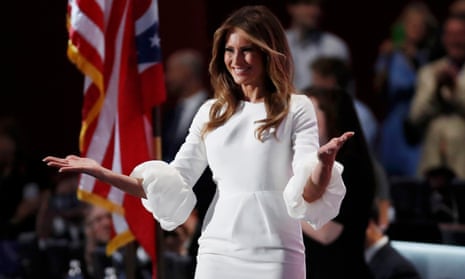Should the hypothesised invitation to Buckingham Palace arrive, Melania Trump will not be able to do as Michelle Obama did and have Tom Ford run up a gown for the occasion. Neither will Marc Jacobs, Phillip Lim or Sophie Theallet – labels of choice for the current first lady – be taking her calls. All of these designers have taken a stand against the incoming administration by making it clear that, as of the inauguration in January, dressing the first lady will cease to be an honour they choose to accept.
This makes no material difference whatsoever. Melania Trump will continue to wear designer clothes of her choice, simply by paying for them. She bought both the white Roksanda “Margot” dress she wore for her Republican convention speech and the Balmain camel coat in which she cast her vote on Net-A-Porter, paying around £1,000 and £2,500 respectively. Fashion industry website Women’s Wear Daily reported that the Ralph Lauren jumpsuit she wore for her husband’s victory speech, which retails for around £3,000, was purchased at full price at Lauren’s Madison Avenue boutique.

So it is fascinating that Ford, Jacobs and co seem to believe that by not dressing Melania Trump they can curb her powers. That by withholding their tailoring skills and their blessing from the first lady, the fashion establishment can somehow keep in check the powers of the Trump administration. As if New York fashion week could stop the Trumps from overstepping the mark, should Congress and the supreme court fail to do so.
Perhaps they can. The link between fashion and politics is stronger now than at any time since Jackie Kennedy. Last week it emerged that Samantha Cameron had repurposed the family dining room as a dressmaking studio during her husband’s time in office, in preparation for the launch of her new fashion brand, Cefinn. That a fashion house born out of Downing Street has been accepted as a natural extension of a power couple’s brand speaks volumes about the extent to which style has infiltrated political discourse.
Jackie, the soon-to-be-released Hollywood biopic starring Natalie Portman as JFK’s widow, takes place over the three days following the assassination of the president in November 1963. But it is the first lady’s wardrobe that is at the heart of this film: the pink Chanel tweed spattered with blood; the black widow’s veil against the stark backdrop of a White House. Glamour and fashion are foregrounded, while the nuts and bolts of political grind are lost in the shadows. A film about politics as theatre and about the dynamic of male-female relationships amplified by power itself, Jackie will arrive in cinemas, with uncanny timing, around the time of the inauguration. When the young widow insists that the public mourning of her husband “has to be beautiful … a big, beautiful funeral everyone will remember”, her instinctive grasp of how aesthetics can shape history feels very modern.
The hostility towards Melania Trump runs against the grain of the fault line that has dominated recent debate about women in political life. From Cherie Blair in her nightie to Hillary Clinton’s scrunchie, most flashpoints have been around women refusing to expend the effort required to conform to celebrity levels of glamour.
Trump, by contrast, is too gaudy for some. “She looks like something out of The Only Way is Essex in those tight-fitting, mono-coloured dresses,” sneered a Spectator blog. That she is reviled for being too glamorous, while Clinton was criticised for being too dowdy, pinpoints the impossibly narrow standards to which women are held. In the iconography of first lady style, it is Jackie Kennedy or bust.

Passing judgment on clothes is a coded way to upbraid women in political life for stepping outside the slender parameters of what is deemed acceptable. Theresa May came under fire this week for a pair of leather trousers she was pictured wearing for a newspaper interview. The ostensible objection to the price tag of £995 was nonsensical: David Cameron wore suits costing more, while Samantha Cameron was routinely admired in dresses by Peter Pilotto or Emilia Wickstead, which cost around the same. May’s real fashion crime was to choose leather trousers – still a mark of rebellion, on a woman. Like leopard print and over-the-knee boots, both of which May is also fond of, leather trousers suggest a level of insubordination. An independently minded woman – or as Ken Clarke might have it, a bloody difficult one.
Such crass assessments reflect that how a woman looks is often conflated with the person she is. This does not happen to men. A man is not defined by his hair, his suit or tie, because the world takes it as read that such things are just part of an identity that is allowed to be – expected to be, even – complex and subtle.
As Jackie Kennedy grasped over half a century ago as she planned her husband’s televised funeral, an ever-more-visual culture changes how politics works. Fashion is part of the political picture now. A little more sophistication in the debate about what women in politics wear would be, as we say in fashion, a good look.

